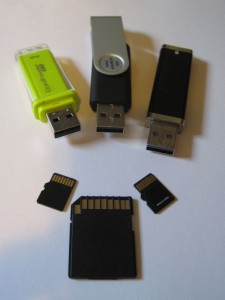In A Flash, You’ve Overpaid For A Storage Upgrade
 The new iPad Air Apple launched Friday and its upcoming retina-display iPad mini bring some welcome changes, but in one aspect they don’t advance things at all.
The new iPad Air Apple launched Friday and its upcoming retina-display iPad mini bring some welcome changes, but in one aspect they don’t advance things at all.
That would be their onboard storage. The 16 GB entry-level storage allocation on each new model and the $100 price to upgrade that to 32 GB remain unchanged since the first iPad’s 2010 debut.
Since then, there’s been a population boom among iPad apps–now 475,000-plus. And many of these apps have themselves bulked up from retina-worthy graphics and other feature additions that, in turn, have eased doing laptop-grade creation that generates accordingly more data on the device.
Unfortunately, the rest of the mobile-device business hasn’t seriously tried to undercut storage pricing that might make the markup on printer ink look reasonable.
The markup for extra storage may look less extreme elsewhere–stepping up from 16 to 32 GB carries a $50 premium on many Android phones–but you’re also more likely to see devices with even weaker entry-level storage. I’ve recently tested a few phones with only 4 GB onboard, leaving barely a gigabyte free for the user.
This is not because flash memory remains a frustratingly-expensive commodity.
Shop for a microSD Card–the easiest fix for inadequate storage on a mobile device, should yours allow that expansion option–and you’ll see how cheap flash memory has become when it’s not sold with a phone or tablet wrapped around it.
Back in 2006, I felt lucky to pay only $30 for a 1 GB SD Card. By 2009, I could get twice the storage at a fifth of the price. Today, $6 easily fetches a 16 GB card, while $30 and change can get you 64 GB.
Another exhibit of this deflation sits on my desk: a growing collection of flash drives given away at press events, whose capacities have steadily ratcheted up. These freebies once came with only 128 megabytes or less each, but 2 GB now represents a minimum allotment in polite company.
I know: Anything you add to a purchase after committing to buy a product—whether it’s extra memory, a protective case or a longer warranty—yields a fatter profit margin. The convenience tax is real and, considering how you can’t exactly pop a new memory module into the motherboard on a phone, not unwarranted.
But storage costs in mobile devices shouldn’t be quite this much of a trailing indicator.
While we wait for those prices to catch up to reality, cloud storage seems like a swell replacement. There, ever-cheaper hosting costs have made capacity too cheap to meter in consumer Web-mail, file-storage and photos-sharing services (some of which, a mere 12 years ago, seemed stuck in a downward spiral of shrinking usage limits and escalating fees).
But cloud services will remain a flawed replacement for local storage because wireless Internet access a) doesn’t work everywhere and b) remains subject to data caps.
Neither of those issues will get solved anytime soon, maybe ever. I can’t count on having constant bandwidth on the Metro into Washington, much less on a cross-country flight, while constantly pushing data from the Web to a mobile device and back is an excellent way to push your usage past the 2 or 3 GB quotas common on wireless plans.
When device manufacturers go crazy with things like screen size and pixel density, why not go nuts with storage–an upgrade you can benefit from without resorting to two-handed use or a magnifying glass? There’s an opening here, if only somebody will take it.








